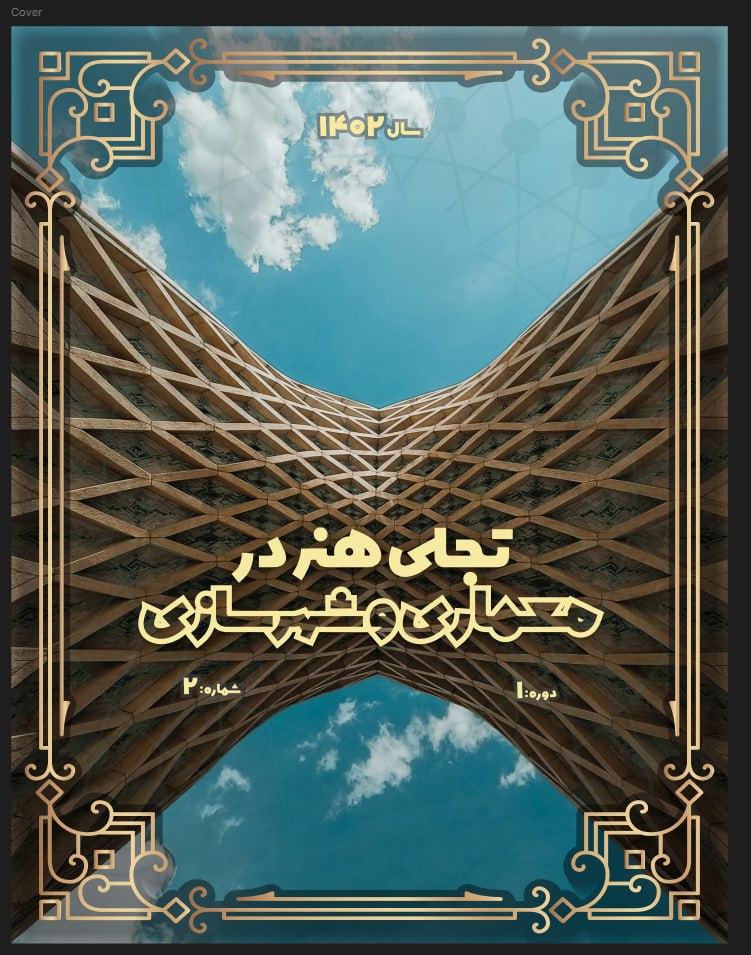رتبهبندی شاخصهای معماری منظر تأثیرگذار بر بهبود کیفی محیط بصری در پارکهای شهری کلانشهر تبریز از منظر اکولوژیک، ویژگیهای فرهنگی، پایداری محیطزیستی و دسترسیپذیری با استفاده از روش TOPSIS
کلمات کلیدی:
معماری منظر, کیفیت محیط بصری, پارک شهری, رضایتمندی شهروندان, تبریز, فضای سبز, عدالت فضاییچکیده
هدف پژوهش، ارزیابی و رتبهبندی شاخصهای مؤثر معماری منظر بر ارتقای کیفیت بصری پارکهای شهری تبریز با تمرکز بر ابعاد اکولوژیک، فرهنگی، پایداری محیطزیستی و دسترسیپذیری است. این پژوهش با رویکرد توصیفی–تحلیلی و روش ترکیبی کمی–کیفی انجام شد. دادهها از طریق پرسشنامه، مصاحبه نیمهساختاریافته و مشاهده میدانی گردآوری شدند. جامعه آماری شامل کاربران شش پارک منتخب تبریز بود که با استفاده از فرمول کوکران، نمونهای ۴۰۰ نفری به روش نمونهگیری تصادفی طبقهای انتخاب شد. دادهها با استفاده از مدلهای چندمعیاره TOPSIS و ANP تحلیل شدند. نتایج نشان داد شاخص «کیفیت اکولوژیکی» و «ویژگیهای فرهنگی» بیشترین وزن نسبی را در بهبود کیفیت محیط بصری دارند. پارک ایلگلی با تنوع زیستی بالا، مدیریت منابع کارآمد و پیوند فرهنگی–تاریخی، رتبه نخست را به دست آورد. پس از آن، پارکهای باغمیشه، شمس تبریزی و باغلار باغی عملکرد بهتری نسبت به سایر پارکها داشتند. پارکهای ارم و خاقانی در پایینترین رتبهها قرار گرفتند که عمدتاً ناشی از ضعف در پایداری، دسترسیپذیری و مشارکت اجتماعی بود. بهبود کیفیت بصری و ارتقای کارکردهای اجتماعی و زیستمحیطی پارکهای تبریز نیازمند تمرکز بر تنوعبخشی پوشش گیاهی بومی، تقویت برنامههای فرهنگی و اجتماعی، توسعه زیرساختهای انرژی و پسماند پایدار، و ارتقای دسترسی عادلانه به ویژه برای افراد دارای معلولیت است. این رویکرد میتواند موجب افزایش هویت شهری، بهبود کیفیت زندگی و بهرهمندی برابر شهروندان از فضاهای سبز شود.
دانلودها
مراجع
1. Abraham A, Sommerhalder K, Abel T. Landscape and well-being: a scoping study on the health-promoting impact of outdoor environments. International journal of public health. 2010;55:59-69.
2. Taghvai SHN, Maleki S, Alidoust S. The Role of the Everyday Landscape in the Quality of Urban Spaces. Case Study: The Path of the Female Dormitory at Shahid Beheshti University. Safd. 2017;26(27):55-72.
3. Akpınar A. How perceived sensory dimensions of urban green spaces are associated with teenagers' perceived restoration, stress, and mental health? Landscape and Urban Planning. 2021;207:104020.
4. Narouei, Il. Evaluating Users' Visual and Aesthetic Preferences of Urban Park Landscapes (Case Study: Sayyad Shirazi Urban Park in Birjand). Human and Environment. 2021;19(2):201-19.
5. Akbari O. Assessing the Suitability of the Spatial Distribution of Tabriz Urban Parks from the Perspective of the Sphere of Influence Using Remote Sensing and GIS. Journal of Renewable Natural Resources Research. 2021;12(1):83-94.
6. Ginzarly M, Houbart C, Teller J. The Historic Urban Landscape approach to urban management: a systematic review. International Journal of Heritage Studies. 2019;25(10):999-1019.
7. Ma'rouf M, Hatamzadeh A, Kaveh H. Improving the Landscape of Urban Parks Based on Citizens' Needs (A Case Study of Gorgan Parks). Sustainable Architecture and Urbanism. 2021;11(3):197-207.
8. Mell IC. Green infrastructure: concepts, perceptions and its use in spatial planning: Newcastle University; 2010.
9. Bayatmaku S. Biophilic Design Efficiency on Humans' Well-being in Daily Life with an Atmospheric Approach. İstanbul: Yüksek Lisans Tezi, İstanbul Teknik Üniversitesi, Lisansüstü Eğitim Enstitüsü, Mimarlık Ana Bilim Dalı, Mimari Tasarım Bilim Dalı; 2022.
10. Felix M, Elhefnawi M. Landscape design elements as a defensive tool for building security. Urban and Transit Planning: A Culmination of Selected Research Papers from IEREK Conferences on Urban Planning, Architecture and Green Urbanism, Italy and Netherlands (2017): Springer International Publishing; 2020. p. 227-38.
11. Abdelhamid MM, Elfakharany MM. Improving urban park usability in developing countries: Case study of Al-Shalalat Park in Alexandria. Alexandria Engineering Journal. 2020;59(1):311-21.
12. Bahriny F, Bell S. Patterns of urban park use and their relationship to factors of quality: A case study of Tehran, Iran. Sustainability. 2020;12(4):1560.
13. Hansen G. Basic principles of landscape design. Florida: University of Florida; 2010. 1-12 p.
14. Huang ASH, Lin YJ. The effect of landscape colour, complexity and preference on viewing behaviour. Landscape Research. 2020;45(2):214-27.
15. Dinda S, Ghosh S. Perceived benefits, aesthetic preferences and willingness to pay for visiting urban parks: A case study in Kolkata, India. International Journal of Geoheritage and Parks. 2021;9(1):36-50.
16. Alidousti Masouleh S, Bamanian MR, Haghighatbin M. Applying Space Syntax to Analyze Behavioral Settings: A Case Study of Neighborhood Parks in District 5 of Tehran Municipality. Naqsh-e Jahan (Role of the World). 2021;11(4):2-24.
17. Nikourai, Mansouri, Haqqjou, Shaghaghi, Shahriar. Evaluating the Effective Factors for the Preservation and Revitalization of Agricultural Lands and Gardens (A Case Study of Lak-dizaj, Tabriz). Journal of Geographic Engineering. 2024;8(3).
18. Harnik P. Urban green: Innovative parks for resurgent cities: Island Press; 2012.
19. Deng L, Li X, Luo H, Fu EK, Ma J, Sun LX, et al. Empirical study of landscape types, landscape elements and landscape components of the urban park promoting physiological and psychological restoration. Urban Forestry & Urban Greening. 2020;48:126488.
20. Bazrafshan M, Tabrizi AM, Bauer N, Kienast F. Place attachment through interaction with urban parks: A cross-cultural study. Urban Forestry & Urban Greening. 2021;61:127103.
21. Rafi ZN, Kazemi F, Tehranifar A. Public preferences toward water-wise landscape design in a summer season. Urban Forestry & Urban Greening. 2020;48:126563.
22. Montazer al H, Sharifnejad. Effective Factors on Users' Perception of the Environmental Quality of Public Leisure Spaces: A Case Study of Yazd City Parks. Quarterly Journal of Urban Studies. 2016;5(20):17-28.
23. Jim CY, Chen SS. Comprehensive greenspace planning based on landscape ecology principles in compact Nanjing city, China. Landscape and urban planning. 2003;65(3):95-116.
24. Escalera-Reyes J. Place attachment, feeling of belonging and collective identity in socio-ecological systems: Study case of Pegalajar (Andalusia-Spain). Sustainability. 2020;12(8):3388.
25. Alpak EM, Özkan DG, Düzenli T. Systems approach in landscape design: a studio work. International Journal of Technology and Design Education. 2018;28:593-611.
26. Hami A. Evaluating the Indicators of Urban Public Landscape Quality. Environmental Planning. 2021(55).
دانلود
چاپ شده
ارسال
بازنگری
پذیرش
شماره
نوع مقاله
مجوز
حق نشر 2025 پریزاد فاخریان (نویسنده); امیر حق جو; حسن ابراهیمی اصل, شهریار شقاقی (نویسنده)

این پروژه تحت مجوز بین المللی Creative Commons Attribution-NonCommercial 4.0 می باشد.









